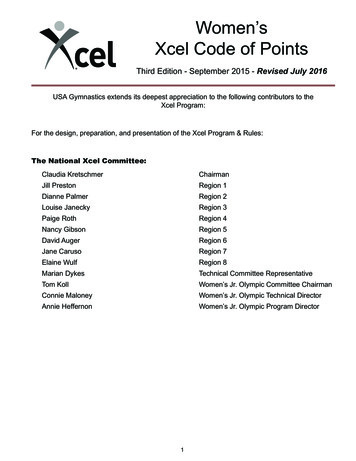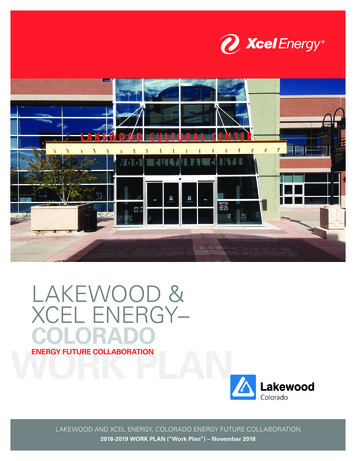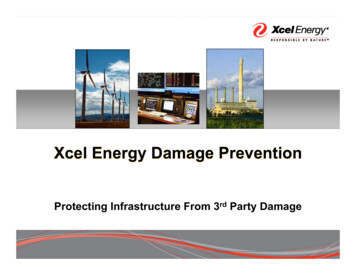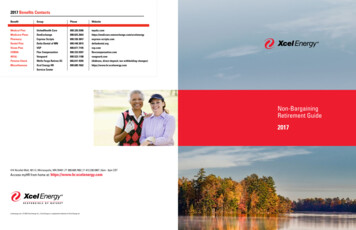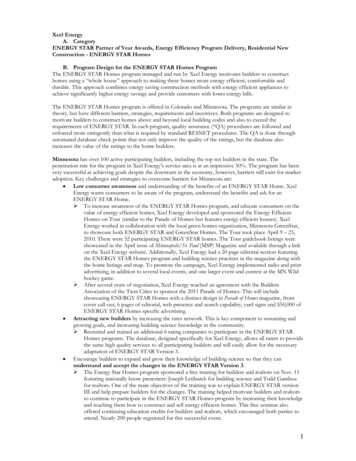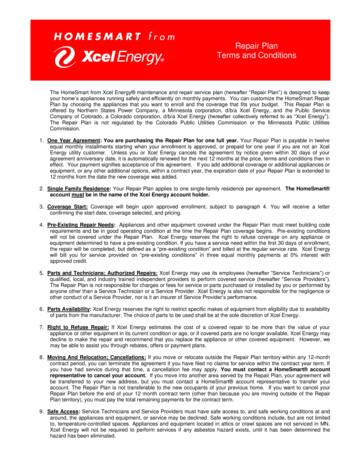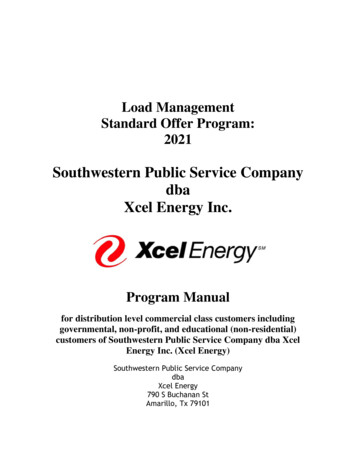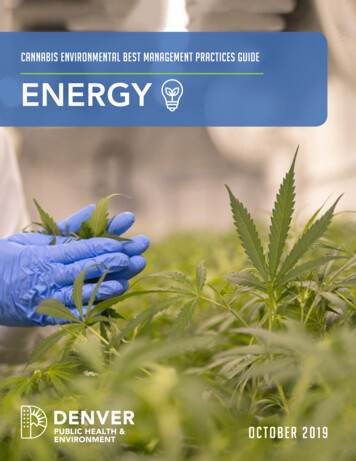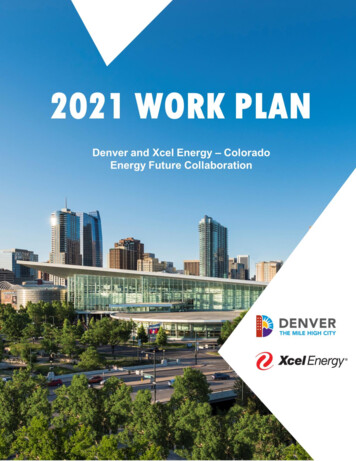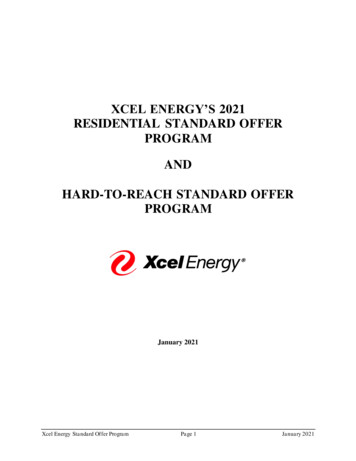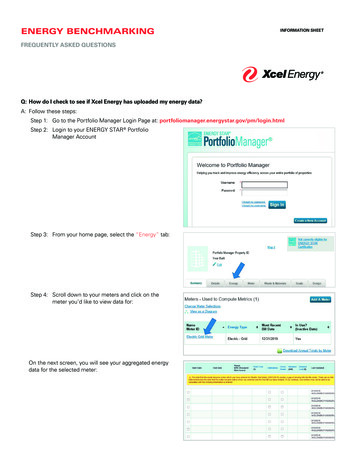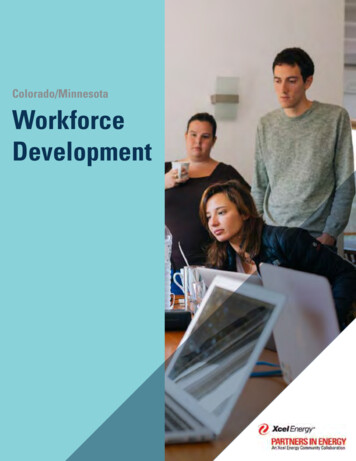
Transcription
Colorado/MinnesotaWorkforceDevelopmentWorkforce Development Toolkit1
XCEL ENERGY PARTNERS IN ENERGY AND THEROLE OF TOOLKITSXcel Energy Partners in Energy provides communities in Minnesota and Coloradofree services to develop an energy plan and assistance with implementing thatplan. Each community has its own unique energy needs and priorities, and Partnersin Energy tailors its services to complement each community’s vision.More and more communities are realizing energy planning plays a critical role inhelping them reach their goals. The benefits of wise energy choices are diverse.By working with citizens, businesses, and even their own government facilities, acommunity can shave dollars off utility bills, promote renewables, drive resourceconservation or contribute toward greenhouse gas reduction goals. Partners inEnergy helps address the challenge of identifying local priorities and then structuresa path that leverages all resources available.As part of this offering, we have developed several toolkits that focus on uniquesectors often identified as a focus for Partners in Energy communities.These toolkitsare intended to help walk users through the process of engaging with these sectorsto realize energy and cost savings.For more information about available toolkits or to customize any of theresources with your community’s unique brand identity, contact yourPartners in Energy facilitator.Workforce Development Toolkit2
Want to help develop your workforce?This kit will help your city prioritize actions and connect you with the tools you’ll need to getstarted. To customize any of the resources with your community’s unique brand identity, contactyour Partners in Energy facilitator.HOW TO USE THIS KITXcel Energy’s Workforce Development Toolkit can help your community provide underrepresentedand disadvantaged groups with job training and resources in the energy industry, while alsoproviding local businesses and residents with energy savings. This toolkit was developed tosupport a workforce development initiative in your community. Xcel Energy assumes no liabilityduring project implementation. This toolkit is only intended to provide information and is not asubstitute for on the job training and proper safety procedures.Kit Organization:Overview 4Why Workforce Development? Partners in Energy and Workforce Development Using the Partners in Energy Process Workforce Development Process and Tools CONTENTGuide to Workforce Development Step 1: Engage Community Stakeholders Step 2: Determine Workforce Gaps & Needs Step 3: Plan Your Initiative Step 4: Identify Projects Step 5: Recruit and Enroll Participants Step 6: Implement Projects Step 7: Reporting Progress Next Steps 456688891012121313Resources 14Step 1: Stakeholder Engagement Step 2: Determine Workforce Gaps & Needs Step 3: Program Planning Step 4: Project Development Step 5: Recruitment & Enrollment Step 6: Project Implementation Step 7: Reporting Additional Tools for Mentors/Mentees 1415151617191919References 20If you have any questions, please feel free to contact your Xcel Energy Partners inEnergy facilitator.Workforce Development Toolkit3
OVERVIEWIn supporting implementation activitiesacrossColoradoandMinnesotacommunities, it is clear that higherlevels of engagement produce improvedoutcomes toward Xcel Energy Partnersin Energy objectives. This toolkit is aimedat communities wishing to mobilize avolunteer base using a mentor/menteemodel to implement projects that willdevelop their skills to enter and beretained in the energy workforce. Forthe purposes of this toolkit, workforcedevelopment refers to this methodologyof engaging those seeking to enter theenergy workforce and providing resumebuilding experiences in the energyindustry. As a volunteer effort focusedon mentorship, implementing this toolkitcan be as simple as engaging high schoolstudents in energy savings opportunitiesat their school, or providing projects foryoung professionals to implement whileconnecting them to potential employers.The toolkit is structured to addressthe most pressing local workforce needs in your community, whether supporting returningveterans, closing the gender gap of women in clean energy, providing increased opportunityfor people of color, immigrant populations or any other socially or economically disadvantagedor underemployed groups within your community. Within the selected need, this WorkforceDevelopment Toolkit (toolkit) targets K-12 and college students interested in science, technology,engineering, and math (STEM) careers as well as existing workforce members interested intransitioning into or growing their skillsets within an energy career. By providing hands onexperience for students and professionals, this toolkit will help communities address theireconomic health and workforce development goals while simultaneously increasing the numberof engaged community members helping to implement energy efficiency and renewable energyprojects across the community.WHY WORKFORCE DEVELOPMENT?Energy efficiency and renewable energy jobs are a growing segment of the energy industry.The energy efficiency sector alone employed over 2 million people and was projected to growby 9 percent in 2018 (Barret & Pollin, 2018) . Minnesota and Colorado have state-wide robustworkforce development systems and benefit from the 2009 American Recovery and ReinvestmentAct (ARRA) that brought national focus on green jobs and the merging of clean energy andeconomic development.Workforce Development Toolkit4
Unfortunately, despite the growth of the industry and efforts in both states to promote energyefficiency and renewable energy training programs, there remain gaps in the workforce thatare not being filled. Employers indicate a lack of experience, training, and technical skills, whiledisadvantaged and underemployed groups face persistent barriers that prevent them fromgaining these job opportunities (Barret & Pollin, 2018). For example, identified disadvantagedand underrepresented groups in Colorado include women and military veterans. In Minnesota,one focus has been a workforce gap across the urban/rural divide.Workforce development provides a way to close these gaps by providing training, mentorship,and placement services across all types of energy jobs, including focused opportunities fordisadvantaged and underrepresented groups. This holistically benefits employers, potentialemployees, and the local economy.PARTNERS IN ENERGY AND WORKFORCE DEVELOPMENTThe Partners in Energy model enables community members to address their community’sworkforce development needs, while simultaneously supporting Partners in Energy on the groundimplementation efforts. Many communities are working on strategies that engage communitymembers in individual actions or actions that collectively motivate others to reduce energyuse. Further, many Partners in Energy communities have dedicated economic developmentdepartments and networks of businesses and agencies focused on workforce development. Thistoolkit seeks to develop opportunities for integrating community workforce development effortsand Partners in Energy implementation.Partnersin Energy Tools for planningprocess Energy Action Teamfor implementation Xcel Energy resourcestoguideprojectimplementationCo-Benefits Implement projects thatgive real world experienceand leverage Xcel Energyprograms to reach savingsgoals Support community needs Support small and midsized employersWorkforceDevelopment Network of potentialparticipants Connection to localbusinesses for projectsfor Citysupportimplementing initiativeand projectsA recent Energy Efficiency Workforce Gap Analysis by the Center for Energy and Environment inMinnesota identified several workforce development needs that closely align with the Partnersin Energy delivery model in both Minnesota and Colorado (Center for Energy and Environment,2018). These gaps include: Better coordination between city sustainability efforts, employers, and the workforcesystem Focused efforts on attraction and retention of women and people of color Better integration of energy efficiency concepts into existing construction trainingprograms Support for small- and mid-size employers in engaging in coordinated workforce initiativesand on-the-job trainingWorkforce Development Toolkit5
USING THE PARTNERS IN ENERGY PROCESSThe Energy Action Team is a crucial component to theworkforce development initiative. Once the EnergyAction Team has identified workforce development asa focus area during the planning phase, the team willhelp build the initiative for the entire community duringimplementation by identifying workforce developmentgaps and needs, working with partner organizations inthe community, and identifying projects and mentors/mentees. Implementation can be a joint effort of theentire Energy Action Team, or a specific focus areaimplementation team.Some specific actions you can take as an Energy ActionTeam member include: Leading the workforce development initiativeplanning Reaching out to potential partner organizations Contacting potential project customers Engaging potential mentees or mentors Acting as a mentor or project customerWORKFORCE DEVELOPMENT PROCESS AND TOOLSThe goal of this toolkit is to engage volunteers and employers to provide hands-on learning tonew energy workforce recruits through mentorship and project implementation. The toolkit willguide users through the process of engaging stakeholders, recruiting mentors and mentees, andidentifying and implementing projects. The toolkit provides a range of tools to help communitiesthrough each step of the process.These steps P03DetermineWorkforceGaps tsRecruit& entProjectsThese steps can be iterative and/or concurrent as needed. For example, Steps 1 and 2 can occurat the same time or teams can engage further stakeholders (step 1) after determining workforcegaps and needs (step 2). The process is designed to provide a guideline for planning the initiative,but should be implemented to best serve each community’s needs.Workforce Development Toolkit6
Workforce Development Initiative Organizational ChartThere are many stakeholders involved in the process outlined below. To better understand eachof these groups, their roles and responsibilities are outlined in the following graphic:Partners in Energy FacilitatorsProvide support andtechnical resourcesWorkforce Development Implementation Team Consist of Energy Action Team members(or subset)Serve as Primary point of contactWork to plan the initiativeProvide ongoing supportCommunity Stakeholders Consist of employers, energyindustry leaders, workforceand/or economic developmentindividualsHelp determine workforce gapsand/or needsSupport planning the initiativeMentor/Mentee Teams Consist of volunteersImplement projects identifiedby the planning processResponsibleforreportingproject progress and resultsWorkforce Development Toolkit7
GUIDE TO WORKFORCE DEVELOPMENTENGAGE COMMUNITY STAKEHOLDERSThe first step is to engage various stakeholders to determine workforce gapsand needs and generate many diverse ideas for projects, mentors, mentees, andorganizations to support. Stakeholders should include those in workforce and/oreconomic development, energy industry employers, and leaders in the energy industry.Stakeholder groups to consider engaging could include: Higher education Local or regional workforce organizations Non-profits Local industry and businesses Utilities Research entities Community clubs and organizations School districts and organizations/clubsResources Potential Organizations Stakeholder Engagement ToolsDETERMINE WORKFORCE GAPS AND NEEDSNext, identify the workforce gaps andneeds in your community workforceand/oreconomicdevelopmentagencies can help determine localized gapsand needs, along with the other stakeholdersidentified in Step 1. This area may already havebeen identified by the Energy Action Team, butif not, work with the community stakeholdersto determine the gap or need to be addressed.Corresponding with the identified gaps andneeds, outline the goals that the workforceinitiative is addressing. Gaps and needs can be asbroad as target groups, or as specific as specificjobs where a gap exists (e.g., energy auditors).Based on research conducted in Colorado andMinnesota, some target groups may include: Women Veterans Urban/rural divide People of color Aging populationsResources Workforce Development InformationResourcesWorkforce Development Toolkit8
PLAN YOUR INITIATIVEThe next step is to bring the stakeholdersidentified in Step 1 together to plan theworkforce development initiative. An in-personworkshop is recommended for this step to engage inproductive discussions to generate a range of ideas for theinitiative. During the workshop, the goals and needs for theworkforce development initiative should be clearly defined.A significant portion of the workshop should be dedicatedto brainstorming projects, recruitment, and outreach andmessaging ideas. Draft workshop materials are providedto get the team started.Once the workshop is completed, the implementationteam should draft a project management plan that includestask identification, schedule, project team roles andresponsibilities, and budget and sources of funding. It willalso be important to continue engaging the communitystakeholders from the workshop with specific actions ortasks that can support the overall initiative.Facilitation Techniques Use some ice breakersfor people to get to knoweach other Give people stickies towrite their ideas on Break into teams to tackledifferent parts of theplanning if you’re tighton time Keep a “parking lot” ofideas to revisitResources Workshop materials»» Brainstorming Question Posters»» PowerPoint Slides»» Notes Template Project Management Plan TemplateWorkforce Development Toolkit9
IDENTIFY PROJECTSProject identification can be done concurrentlywith the previous steps if desired andcontinue following the planning phases. Theimplementation team and community stakeholders can allassist in project development. Consider starting with thetargets set in the Energy Action Plan to inform what projectsto start focusing on and expand as necessary. Initially, allproject ideas related to energy efficiency and renewableenergy should be recorded in the project roster template.After an initial brainstorming of projects, the team shoulddecide what criteria are most important and review the listbased on these criteria.Beyond theEnergy Action PlanTargets from the EnergyAction Plan are a goodplace to start, but yourcommunity can also use thistoolkit outside of the EnergyAction Plan, or expandon previously completedefforts. Consider any typeof energy efficiency orrenewable energy projectfor these!Some criteria to consider when assessing projects mightinclude: Can it be completed within the initiative time frame? Will there be realized energy savings or an increasein renewable energy resources? Does it help the community achieve its Energy Action Plan goals? Does the project directly impact the selected workforce development gap and need?It is also important to make sure there are enough feasible projects for the anticipated number ofmentor/mentee teams. Engaging with potential project customers early in the process can helpto determine feasibility and other criteria.Partners in Energy resources can also be leveraged for implementing projects that meet thecommunity’s Energy Action Plan goals! There are a variety of additional toolkits that teams coulduse to brainstorm and assess projects. Other Partners in Energy Toolkits include Congregations,Small Businesses, and Multifamily Buildings.Workforce Development Toolkit10
Xcel Energy demand-side management (DSM) programscan provide a good starting point for types of projects toimplement and can provide project customers with savingson projects. Some example projects and associated XcelEnergy programs are in the table below.Project ExampleMore ProgramsFor more programs, visitXcel Energy’s website.Xcel Energy Program Knowledge or Experience GainedDoor-to-door lighting walks Reach out to local businesses to Lighting Efficiencydetermine quantity and type of/ Small Businesslighting and connect with XcelLightingEnergy lighting rebate programs Equipment Assessment Determine a business’Equipment rebates(e.g., heating,equipment type, age, andcondition and connect with Xcel cooling, etc.)Energy equipment rebates Multifamily Housing Engagement Reach out to multifamilyhousing building owners toMultifamily Buildingprovide information aboutEfficiencyenergy-savings opportunitiesand Xcel Energy programs andhelp them determine energy use Knowledge of commerciallighting systemsFinancial return for projectsOutreach & communicationskillsKnowledge of equipmenttypesExperience auditingequipmentFinancial return for projectsBuilding energy auditexperienceOutreach & communicationskillsTo assist your team in reaching out to potential project customers, draft outreach materials areincluded in this toolkit.Resources Project Roster Template Project Customer Recruitment Flyer Email TemplateWorkforce Development Toolkit11
RECRUIT AND ENROLL PARTICIPANTSOnce projects are identified, it will be important to make sure the number of projectslines up with the number of mentor/mentee teams. Both mentees and mentors willbe recruited and engaged in the initiative. Teams of multiple mentees to mentors canbe formed, rather than pairs, but try to keep the groups small to ensure adequate engagementand development for all mentees.The local workforce/economic development agency and other partner organizations will likelybe able to assist in finding and recruiting mentees within the workforce gap your community haschosen to focus on. Mentees should be able to commit to the full program length and be willingto engage in projects and mentorship activities. An option is to also engage local STEM (science,technology, engineering, math) organizations at local high schools and/or colleges, communitycolleges, or trade schools.Mentors can be drawn from the stakeholder engagementprocess and workshop completed earlier in the initiative, aswell as additional resources from the local energy industry.These may come from companies that are on the projectroster as well, providing technical support and mentorshipwhile also implementing projects at their business.Resources Recruitment collateral»» Mentees»» Mentors»» Project Menu Suggested Outreach Methods Mentee Recruitment Email Template Mentor Recruitment Email TemplateTechnical SupportIf you need more technicalresources for your mentors,reach out to your facilitationteam.IMPLEMENT PROJECTSDuring implementation, mentor/mentee project teams will be working with theirproject customer to deliver the project. The implementation period should last around6-7 months, but exact duration should be finalized during the initiative planningstages. The planning team will provide general and technical support during this phase on an asneeded basis and should engage with project teams periodically with tips to keep projects ontrack. Teams should be encouraged to track progress and document activities with photos.Networking events for all project teams are also an option during this time and provide a goodway for mentors and mentees to interact with other participants in the initiative. Some ideas fornetworking events include breakfasts, lunch-and-learns, speed networking, career panels withpotential employers, job site tours, resume workshops, etc.The implementation team will act as an initial resource for mentor/mentee teams for anyquestions about projects or project implementation, with support from the Partners in Energyfacilitation team.Resources Xcel Energy Program & Rebate InformationWorkforce Development Toolkit12
REPORT PROGRESSTracking and reporting progress on projectimplementation will be important to determinethe success of the initiative and changes tomake for future years. Teams of mentees/mentors shouldcomplete a reporting template that the implementationteam can then aggregate across all projects to deriveinitiative results.It is also important to get mentee, mentor, and projectcustomer feedback about the program. There can be manyways to do this, such as using surveys, or during a finaldebrief and celebration event. The planning team shouldbe sure to incorporate this feedback into future programimplementations.Celebrate SuccessBe sure to celebrate yourmentor/mentee teams torecognize their hard work! Thisis a good place to showcaseall of the projects completedand energy saved and anyprogress mentees have madeon their career development.Resources Metrics & Reporting Templates»» Project Report Template»» Project Results Template Program Feedback»» Feedback Survey»» Certificate of Appreciation Additional ToolsNEXT STEPSNear the end of the first year of the program, the planning team should reconvene to assessprogress, document lessons learned, and plan the next steps of the program. Some questions toconsider during this meeting include: Did we meet (or miss) our objectives? What caused us to meet (or miss) our objectives? What did we do right? What did we do wrong? Based on the program management plan, are we on track to offer this again next year? Are current partners/funders willing to support again? What new partners/funding sourcesmight be interested in getting involved? What changes or improvements should be made to the initiative? What changes should bemade to associated initiative materials?Workforce Development Toolkit13
Xcel Energy Partners in Energy provides communities in Minnesota and Colorado free services to develop an energy plan and assistance with implementing that plan. Each community has its own unique energy needs and priorities, and Partners in Energy tailors its services to complement each community's vision. More and more communities are .
